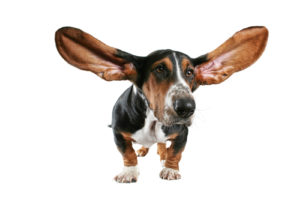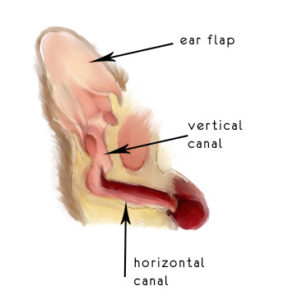
Written by Sara Farmer, DVM Veterinarian
From Petcoach
Whether they’re long and floppy or they stick straight up, your dog’s ears are clearly very different from your own. Did you know a dog’s ear canal itself is actually L shaped, with distinct vertical and horizontal portions? For this reason in particular the proper way to clean your dog’s ears might not be very obvious. Keep reading to avoid some common mistakes. Using the wrong ear cleaning solution

Simple illustration of the inside of a dog’s ear.
Because a dog’s ear is L shaped, it is important to use an ear cleaning solution to help clean out the hard to reach horizontal canal. You should choose an ear wash that contains ingredients that help acidify and dry out the ear canal. Some examples include boric acid, acetic acid, and lactic acid. Your veterinarian likely has a variety of specialized products that also contain ingredients to break down earwax and even some that potentially help prevent attachment of bacteria or yeast to the wall of the canal. In a pinch, a mixture of one-part white vinegar to two-parts water can be used. Ask your veterinarian for recommendations.
Not using enough ear cleaning solution
For optimal cleaning, you should completely fill your dog’s ear canal with a cleaning solution until you can see the fluid pooling in the ear canal, then close the ear flap over the opening. The next step is to massage the base of the ear until you can hear a ‘sucking’ noise. This suction helps pull debris from deep within the horizontal canal. Pulling the pinna (ear flap) up can help open the canal so you can easily access the opening. If it is too difficult to pour solution in you can also soak a large cotton ball with cleaning solution and place at the opening of the canal before massaging.
Using a cotton swab
After you use a cleaning solution, you need to remove the excess liquid and as much debris as possible to get those ears squeaky clean. Cotton swabs tend to push wax and debris farther into the ear canal where they can no longer be removed. It’s better to use a tissue or cotton ball or pad to help remove debris from the crevices that form the opening to the ear canal. If you do need to use a cotton swab to clean in between crevices, make sure you can always see the tip.
Disciplining your dog during the cleaning process
Most dogs don’t particularly like having their ears cleaned, and you want to do everything possible to make this a good experience for you and your dog. Practice holding and handling your dog’s ears before you plan to actually clean them to help your dog get used to being handled. You can have a partner give treats while you are cleaning your dog’s ears, or you can spread a sticky treat like a small amount of canned food or peanut butter (check with your veterinarian first) onto a plate for distraction. If your dog seems stressed or upset, wait a few minutes or even hours before trying again. Now is not the time for punishment as your dog will likely have negative associations with ear cleaning. This could make ear cleaning much harder the next time around.
Ear cleaning is messy business! Your dog will likely shake its head as soon as possible, spraying you and the surrounding area with earwax and cleaning solution. You may want to clean your dog’s ears outside or in a bathroom or other area where surfaces can easily be cleaned. Another trick is to place a towel over your dog’s head after pouring in the ear cleaning solution but before shaking starts.
Waiting to see your veterinarian
While a small amount of earwax can be normal, you should contact your veterinarian if there is a foul smell, if your dog is shaking its head or scratching excessively, or if one or both ears seem red. These can be signs of a bacterial or fungal ear infection. Ear infections are very common in dogs and prescription topical medications that contain antibiotics, antifungals, and/or corticosteroids are generally necessary for treatment. If left untreated an ear infection can cause permanent damage to the ear canal, or can lead to a more serious middle or inner ear infection. If you’re suspicious your dog may have an ear infection, make an appointment to see your veterinarian before cleaning the ears as sometimes this can make confirming an ear infection more difficult.








